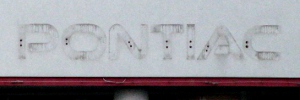















Pontiac alternator: Efficient charging component of your car's electrical system |
|---|

|
Anthony Fontanelle
September 10, 2007
More than three decades ago, automotive electrical systems are made up of simple wirings and connections to activate the major components of your car. Due to the onslaught of technology, more complex electrical system components have been added to improve the way your car performs on the road. They may have undergone some major changes, but the basic electrical anatomy of your Pontiac has been the same. Your basic electrical system includes a means to replenish the electrical energy, a storage device, and a passageway through which the electrical energy may flow. So in essence, the basic electrical system of your Pontiac vehicle includes the wiring, alternator and battery. As a unit, they convert your car’s mechanical energy into electrical energy. Your Pontiac alternator is among the many components of your car’s electrical system that contributes a major role in activating the various systems in your car. It serves two basic functions: one is to recharge the vehicle’s battery by generating current; and the other one is to run the entire electrical system by generating electrical power.
The Pontiac alternator installed on your car is composed of several parts that aids in performing its intended function. It contains a rectifier bridge that is included in the diode assembly, a stator that serves as a stationary induction winding, a rotating field winding called the rotor, 2 internal fans that regulate air circulation, and a voltage regulator that serves as a control device. A typical alternator goes through 4 steps to make its work complete. First, the alternator rotor is driven by the engine through the use of an engine belt and pulley. After that, the activated alternator rotor will spin inside the windings of the stator. Next, the stator windings would produce an alternating current. And lastly, the rectifier bridge will convert the alternating current into direct current. Although your Pontiac alternator normally undergoes these four stages, it does not constantly produce electricity. As a matter of fact, it cycles on and off especially when the demands go up and down.
Preventative maintenance would help extend the service life of your Pontiac alternator. Among the basic things that you should do is to make sure that the alternator drive belt is in good condition, proper tension, and correct alignment. However, normal aging can cause this electrical system component to wear out despite careful monitoring and maintenance. Unusual alternator noises can be heard as a sign of wear and tear such as a hissing sound and squealing sound. Pulsating magnetic field and vibration can make one or more of your diodes ineffective, resulting to those hissing sounds. On the other hand, squealing sounds may be an indication of an improperly tensioned and adjusted drive belt or a bearing problem. Having a worn out Pontiac alternator would not readily make your car lay motionless. This is because your battery has some stored energy which can make your car run for some more miles. However, it would be wise to replace them immediately with a new one once you have noticed those tell tale signs of damage. You would not want to get your car stuck on an unfamiliar road, wouldn’t you?
Source: Amazines.com
